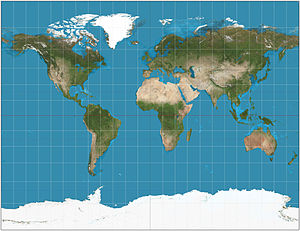Gall stereographic projection


TheGall stereographic projection,presented byJames Gallin 1855, is acylindrical projection.It is neitherequal-areanorconformalbut instead tries to balance the distortion inherent in any projection.
Formulae
[edit]The projection is conventionally defined as:[1]
whereλis the longitude from the central meridian in degrees,φis the latitude, andRis the radius of the globe used as the model of the earth for projection. It is a perspective projection if the point of projection is allowed to vary with longitude: the point of projection being on the equator on the opposite side of the earth from the point being mapped and with the projective surface being a cylinder secant to the sphere at 45°N and 45°S.[2]Gall called the projection "stereographic" because the spacing of theparallelsis the same as the spacing of the parallels along the centralmeridianof the equatorialstereographic projection.
The reverse projection is defined as:
Braun stereographic projection
[edit]This later (1867) cylindrical projection by Carl Braun is similar, differing only in the asymmetric scaling horizontally and vertically. This yields a projection tangent to the sphere.[3]Its formula is:
See also
[edit]References
[edit]- ^Snyder 1993,p. 109.
- ^[1]Archived2018-07-21 at theWayback Machineaccessed 20 April 2013
- ^[2]Archived2013-01-20 at theWayback Machinedownloaded 20 April 2013
Bibliography
[edit]- Snyder, John P (1993).Flattening the Earth.University of Chicago Press.ISBN978-0-226-76747-5.
Further reading
[edit]- Snyder, John P (1987).Map Projections—A Working Manual: USGS Professional Paper 1395.U.S. Government Printing Office.doi:10.3133/pp1395.



